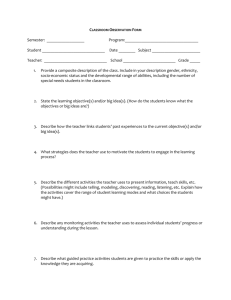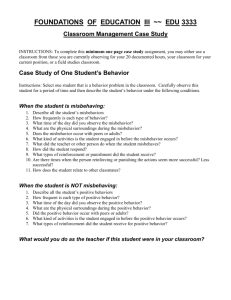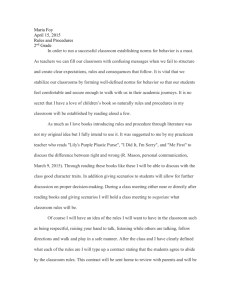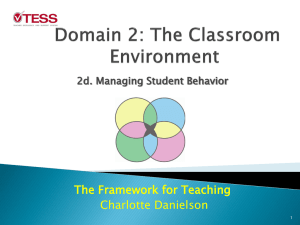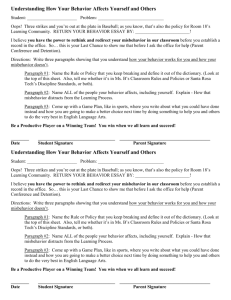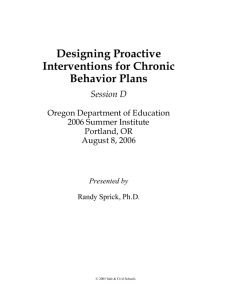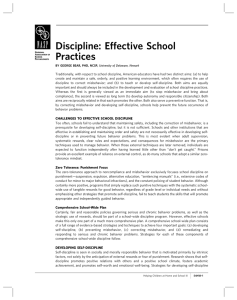Research & Analysis Chapter 4
advertisement
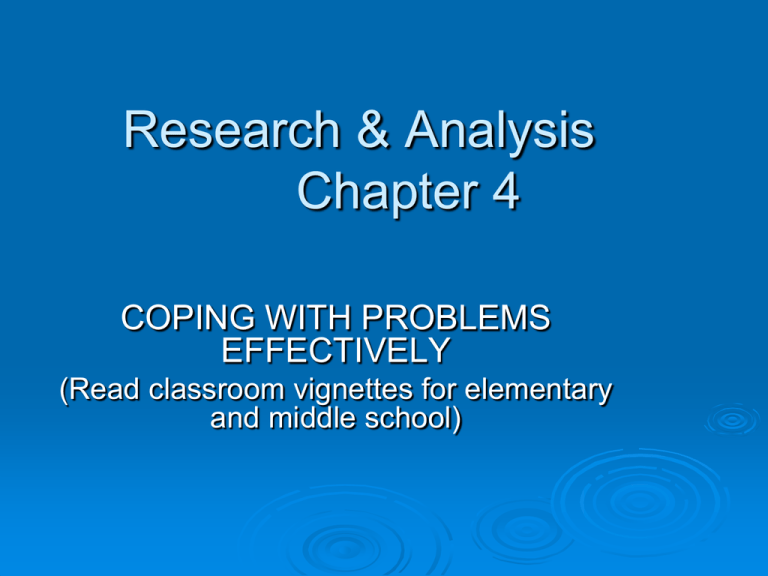
Research & Analysis Chapter 4 COPING WITH PROBLEMS EFFECTIVELY (Read classroom vignettes for elementary and middle school) Dealing with Minor Inattention and Misbehavior Monitor the Entire Classroom Regularly scan the room “nip problems in the bud” Ignore Minor, Fleeting Misbehavior intervention may be more disruptive decide what is “fleeting” Stop Sustained Minor Misbehavior Minor Inattention & Misbehavior (cont’d) Use the following techniques to redirect inattentive students: Eye contct and gesture. Touch. Physical proximity. Asking for responses. Name dropping. Dealing with Prolonged or Disruptive Misbehavior Appropriate Direct Correction Name the student and indicate what they should be doing. Remind students of rules and expectations. Brief rule reminders are more desirable than demanding behaviors. Dealing with Prolonged or Disruptive Misbehavior (cont’d) Inappropriate Direct Correction Do not as questions about obvious Misbehavior. Avoid unnecessary threats & displays of authority. Avoid dwelling on misbehavior (nagging). Conducting Investigations Talk in private. Some questions about intentions may be needed to establish what the student was doing and why. Do not berate students, impugn their motives or raise issues that they cannot answer. When responses conflict, point out the discrepancies. Construct a list of student behaviors that are most likely to embarrass you or make you anxious. Practice how you will deal with these. Conflict Resolution Thomas Gordon AND Jones & Jones’ 7-step problem-solving model Students with chronic personality or behavioral problems THOMAS GORDON –”No-lose” approach Analyzes degree to which each party “owns” the problem. Teacher-owned problem when teacher’s needs are being frustrated. Student-owned problem when the student’s needs are being frustrated. Thomas Gordon Behavior Window Other owns the problem Active Listening No Problem You own the problem We own the problem Collision of values “I“messages Conflict Resolution Values Clarification Gordon’s 6-step “no-lose” method 1) 2) 3) 4) 5) 6) Define the problem. Generate possible solutions. Evaluate those solutions. Decide which is best. Determine how to implement the best solution Assess the effectiveness of this solution after implementation. If it is not working for all concerned, negotiate a new agreement. Jones & Jones 7-step model for solving classroom problems 1) 2) 3) 4) 5) 6) 7) Establish a warm, personal relationship. Ask clarification questions to find out the nature and reasons for the behavior. Help student make a value judgment such as, “Is this behavior helping you?” Work out a plan he/she can do differently. Elicit a commitment from the student to follow the plan. After a time, meet to see if plan is working. When students don’t follow through on their commitments, persist and develop a new plan. Schoolwide programs Curwin & Mendler--Discipline w/ Dignity The Discipline with Dignity model stresses that teachers must offer choices to students as a result of their actions, use humor, and disregard excuses. Teachers are largely responsible for the behavior that students display in their classroom. Prevention: What can be done to minimize problems. Action: What is to be done once problems occur. Resolution: What can be done for the chronic misbehaver. Fay & Funk Teaching w/ Love & Logic The Love and Logic philosophy states the importance of adults providing limits in a caring way. It involves building students up so they feel more capable, even after being disciplined. When interacting with students, educators need to stay calm and avoid provoking, threatening, moralizing or lecturing. Educators should use polite statements that are enforceable and offer children choices within limits, thus avoiding power struggles. They describe childhood misbehavior as an opportunity for helping children grow through their mistakes. Their methods help children learn to be responsible and gain self-confidence. Jerome Freiberg & Carl Rogers Freedom to Learn The role of the teacher is to facilitate experiential learning by: 1. setting a positive climate for learning 2. clarifying the purposes of the learner(s) 3. organizing and making available learning resources 4. balancing intellectual and emotional components of learning and 5. sharing feelings and thoughts with learners but not dominating. Freiberg-- Consistency Management and Cooperative Discipline (CMCD) --- a research-based, classroom-tested model that builds on shared responsibility for learning and classroom organization between teachers and students. The teacher creates a consistent but flexible learning environment and joins with the students in establishing a cooperative plan for classroom rules, procedures, use of time, and academic learning that governs the classroom. Five themes: Prevention, Caring, Cooperation, Organization, and Community. Each theme includes strategies and activities that allow students to become real partners in the classroom. Punishment (Healthy Active Children Policy in North Carolina) http://www.nchealthyschools.org/components/healthyactivechildrenpoli cy Section 3. RECESS AND PHYSICAL ACTIVITY Structured/unstructured recess and other physical activity (such as, but not limited to, physical activity time, physical education or intramurals) shall not be taken away from students as a form of punishment. In addition, severe and/or inappropriate exercise may not be used as a form of punishment for students. Section 3. RECESS AND PHYSICAL ACTIVITY (Cont.) A minimum of 30 minutes of moderate to vigorous physical activity shall be provided by schools for all K-8 students daily. This requirement can be achieved through a regular physical education class and/or through activities such as recess, dance, classroom energizers, or other curriculum based physical education activity programs. However, such use of this time should complement and not substitute for the physical education program. Section 3. RECESS AND PHYSICAL ACTIVITY (Cont.) The physical activity required by this section must involve physical exertion of at least a moderate to vigorous intensity level and for a duration sufficient to provide a significant health benefit to students. Positive Behavior Intervention and Support (PBIS) Recently implemented in most CMS schools: **focuses on teaching, modeling, practicing, and reinforcing desired behaviors. **different instructional strategies are used w/ students who struggle w/ behavior, just as schools use to help students who struggle with academics. Punishment Achieves limited, temporary success Increases tension and conflict Develops overt obedience but not covert selfcontrol Signifies that teacher cannot cope with the problem Communicates lack of confidence in students and that they are not trying to improve Can damage self-concept and reduce cooperation Effective Punishment Used only as a last resort, after continued expressions of concern and assistance, when students repeatedly fail to respond to more positive treatment Not appropriate for isolated incidents Should only be part of a planned response for repeated misbehavior ***Apply without anger or vengefulness: Fair warning Ensure students last resort----no other choice Ensure students you don’t enjoy punishing Apply w/ quiet, professional tone Should be related to the offense and reasonable Inappropriate Punishment Abusive Verbal Attacks- no corrective function and causes resentment to attacker Physical Punishment- teaches to attack others when angry, not appropriate behavior Extra Work- schoolwork is then seen as drudgery---may complete a behavior statement followed by a discussion with teacher Lowering Academic Grades- further alienated low achievers from academic efforts Other Approaches to Classroom Management Textbook authors (Brophy & Good) 3 approach to classroom management are eclectic, stressing principles gathered from many theories. Three of the most prominent will conclude chapter 4. Assertive Discipline Contingency Contracting Cognitive Behavior Modification Assertive Discipline Lee & Marlene CANTER
